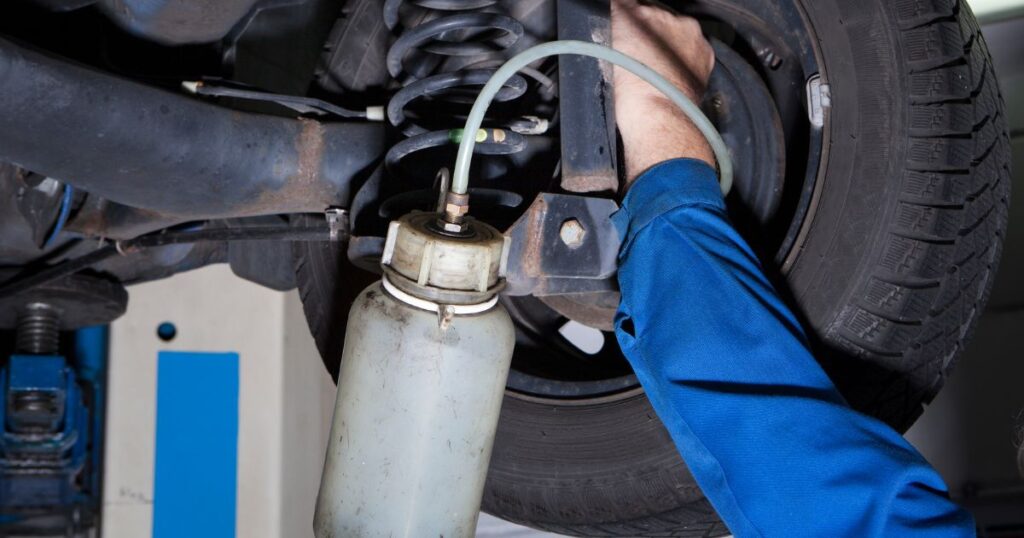The brake system in a car plays a crucial role in ensuring safety. While brake issues are often noticeable when the vehicle is turned off, there are instances where problems arise only when the engine is running. One such issue is the lack of brake pressure when the car is in motion. In this article, we will explore the possible causes of this problem and provide troubleshooting steps to address them effectively.
What Are The Causes of No Brake Pressure When Car Is Running?
Brake Fluid Leak
One potential cause of no brake pressure is a brake fluid leak. Worn-out seals or hoses can develop small leaks that may not be noticeable when the engine is off. However, when the brake booster activates with the engine running, these components may expand, leading to fluid leakage.

Troubleshooting and Solution
- Start the engine and allow it to run for a few minutes.
- Press the brake pedal multiple times while inspecting for any signs of leaks, such as fluid drips or puddles near the wheels.
- Carefully examine the brake lines, hoses, calipers, and wheel cylinders for wet or oily areas.
- Identify the component causing the leak and replace or repair it accordingly, ensuring the use of high-quality replacement parts.
- After fixing the issue, refill the brake fluid reservoir with the recommended type and bleed the brake system if air has entered during the repair process.
Pressure Leak
Another possible cause of no brake pressure is a pressure leak in the system. Weak or worn-out hoses may expand when the brake booster is activated, decreasing pressure, especially if the brake fluid level is low. Worn brake shoes can also contribute to this problem by necessitating excessive fluid to create sufficient contact, leading to a spongy braking feel.
Troubleshooting and Solution
- Start the engine and press the brake pedal several times to build up pressure.
- Keep the pedal pressed and inspect the brake lines from the master cylinder to the wheels, looking for swollen hoses that may burst soon. Replace any compromised hoses.
- Remove the wheels and check the condition of the brake shoes. If they are excessively worn, replace them.
- Refill the brake fluid reservoir, especially if the pressure leak becomes noticeable when the fluid level is low.
- Bleed the brake fluid line if the air is suspected to be present, as it can also cause pressure loss.
Also checkout these post:
- Toyota 4Runner Rear Door Lock Problem [Possible Cause & Fixes]
- What Would Happen If I Unplug My Fuel Composition Sensor?
Air in the Brake System

The presence of air in the brake system can lead to a loss of brake pressure when the car is running. Air can enter the system through leaks or during brake fluid replacement. When air is present in the brake lines, it compresses under pressure, resulting in a spongy or soft brake pedal feel.
Troubleshooting and Solution
- Check the brake fluid level in the reservoir. If it is low, it may indicate a leak or insufficient fluid to purge the air from the system. Refill the reservoir with the recommended brake fluid type.
- Locate the brake bleeder valves on each brake caliper or wheel cylinder, typically at the highest brake system point.
- With the engine running, have an assistant slowly press and hold down the brake pedal while you open the bleeder valve briefly to release any air and fluid. Close the valve before releasing the brake pedal.
- Repeat the process of pressing the brake pedal, opening the bleeder valve, and closing it until a steady stream of brake fluid without air bubbles is observed.
- Regularly check the brake fluid reservoir during bleeding and refill as necessary.
- Repeat the bleeding procedure for all four wheels, ensuring all connections are secure and there are no leaks.
Failing or Faulty ABS System
In rare cases, a failing or faulty ABS (anti-lock braking system) can cause a loss of brake pressure. The ABS prevents wheel lock-up during sudden stops and slippery road conditions. If the ABS modulator malfunctions, it can result in a loss of brake pressure. An ABS warning light may accompany this issue, although it may not always be displayed. It’s important to note that not all vehicles have ABS systems.
Troubleshooting and Solution
- Verify if your vehicle is equipped with an ABS by consulting the owner’s manual or seeking assistance from a professional mechanic.
- If your car has an ABS and the ABS warning light is on, have it diagnosed by a qualified mechanic who can use specialized diagnostic tools to identify the problem.
- The mechanic will thoroughly inspect the ABS components, including the sensors, control module, hydraulic unit, and wiring, to pinpoint the cause of the issue.
- Repair or replace the faulty ABS component based on the diagnosis, ensuring the use of OEM parts or suitable replacements for proper functioning.
Conclusion
No brake pressure when the car is running can be attributed to various factors, including brake fluid leaks, pressure leaks, the air in the brake system, or a failing ABS system (if equipped). To address these issues, thorough troubleshooting and appropriate solutions are necessary. Inspect and repair or replace the affected components, refill the brake fluid reservoir, and bleed the brake system if needed. Promptly addressing brake issues is vital for ensuring driving safety.
Frequently Asked Questions (FAQs):
Q: Can a failing or faulty brake booster cause no brake pressure when a car is running?
A: No, a failing brake booster typically results in a hard brake pedal and increased braking distance rather than causing a lack of brake pressure.
Q: Is it safe to drive with low brake pressure or when the brake pedal goes to the floor?
A: No, it is not safe to drive under such conditions. A loss of brake pressure indicates a brake issue that should be addressed immediately to prevent brake failure.
